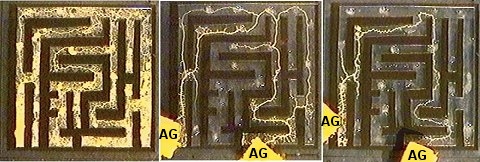
(Image is from the article being discussed.)
I recently ran across a 14-year-old study that I found incredibly interesting. I normally discuss studies that have occurred in the past few years on this blog, but since this study goes well with two other blog posts I have written (here and here), I thought I would go ahead and write about this one as well. In the experiment, the authors studied a slime mold (Physarum polycephalum) that was in its plasmodium stage. During this stage of its life, it is a huge, single cell that has thousands of nuclei.
The researchers grew the slime mold on a maze (as shown on the far left of the image above). Once it had covered the maze, they put out some food in the form of nutrient-rich agar (labelled “AG” in the image above). They put one source of food at the beginning of the maze and another source of food at the end. There were four paths through the maze that connected the two food sources. In a mere four hours, the slime mold had built connections between the two sources using all four of the paths (as shown in the middle of the image above). However, in another four hours, it had worked out the shortest of the four routes (as shown on the right of the image above), and that’s the only one it maintained.
Now as I pointed out in my other two posts about slime molds, these organisms are thought to be “primitive,” because they are thought to have evolved long ago, even before plants and animal evolved. Nevertheless, when presented with puzzles, they are able to solve them. In fact, in one of the previous studies I wrote about, it was suggested that these “primitive” organisms could help us design better networks. Based on the results of this study, such networks would probably be very efficient.
In my high-school biology course, I stress over and over again that there is no such thing as a “simple” organism. The more we study nature, the more clear that becomes.

Dr Wile, thus makes us wonder “How?” Since you name that the mold could “solve” the maze, are you suggesting intelligence? Are you suggesting that the mold could sort out preferences for less wasted energy and shut down the less efficient members? Any suggestions for the process that resulted in a pattern of “the shortest route?”
Thanks.
I am not sure I know the answer to your question, Bill. The authors of the study say that there must be some “primitive intelligence” (their words) in the slime mold. I guess it depends on what you mean by “intelligence.” I suspect that slime molds have been engineered to be very efficient, so there is probably some sensing mechanism that measures how much food is taken in from each route and how much net energy is generated. This sensing mechanism allows inefficient routes to be shut down when more efficient routes exist. You could call that “intelligence,” or you could call it “good engineering.”
Or it could be as simple as maintaining the most optimal feedback circuit and close down the others. No intelligence required except in the initial design of the organism.
We do this today with robots, computer networks, etc. This might be a better way to do our designs because we would be using a much more complicated feedback and control system (one that we can’t yet explain, design or build).
That’s a very good possibility, Hill Strong. I would agree that there isn’t necessarily any requirement of intelligence in the organism. However, a feedback circuit like what you describe would indicate an intelligence in the design of the organism.